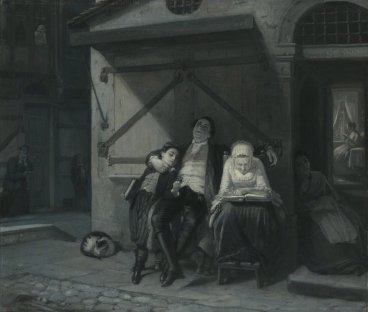
This painting, by 19th century German Jewish painter Daniel Moritz Oppenheim, depicts a Jewish family relaxing on a Shabbat afternoon. While the patriarch of the family sits at the center of the tableau, the light in the painting shines on the two women who are reading. There is no way to tell what the women are reading, but art historians assume that the older woman in the foreground is reading a traditional Jewish tome, perhaps a siddur, or the Tzena u’Rena, while the younger woman in the rear is immersed in a contemporary German novel. It’s this assumption, as well as the inscription “1789” above the door mantel, that leads the Jewish Museum catalogue to say the following about the painting :
“Grandmother, hair covered, reads a traditional prayer book for women. Through the doorway symbolically leading to the future, her modern, bareheaded granddaughter enjoys the latest novel…”
“Seemingly peaceful, this scene harbors dynamic undercurrents. It honors a political revolution and contains seeds of feminist action.”
While the museum chooses to focus on the discord present in the painting, I am struck by the continuity between the young woman reading a novel, and her perhaps more religious counterpart. Their bodies are hunched in similar positions, and they also share a look of intense absorption that distinguishes them from the rest of their family. Together they present a vision of the Jewish Sabbath that is both vibrant and serene, their absorption in texts is a dynamic alternative to both political action and actual slumber. I suspect that Oppenheim leaves the question of whether they are reading sacred or secular texts intentionally open, it is the act of reading itself that seems to define their experience of the Sabbath. Despite the winds of change that are alluded to in the painting, there is the possibility that this is one tradition that will endure.

A beautiful and persuasive interpretation of this painting and the reading practices it depicts!
LikeLiked by 1 person
I was instantly curious about this image on your site, Sarah, and so glad to find this information and your interpretation. It’s also great to discover the connection of the image, which intrigued me immediately, to what you have named—and the focus of—your site. I am really looking forward to reading your work here! I have a very strong interest in the intersection of Judaism and literature. So happy to find my way here.
LikeLiked by 1 person
Thank you! So glad you made it here too!
LikeLike
Everyone sees what they want. I see the young boy holding a religious tome, perhaps the Talmud. The father is “spent” after having studied with his son. I assume the daughter in the backgroud reads from a smaller-sized text while the aging mother literally leans on her larger sized teaxt that has seen her through many years. I am open to the daughter reading a book-of-the-day, it is left to the imagination as Sara aptly added.
LikeLiked by 1 person